[China Aluminum Network] article published in Lw2016 proceedings - author Zhou Jiarong (Shanghai Aluminum Industry Association expert committee)
Abstract: Several forms of aluminum alloy slab production were briefly described, some problems that should be paid attention to in the slab production process were pointed out, and a new generation of electromagnetic casting, high-power ultrasonic casting, semi-solid casting, injection casting and ingot casting was specifically described. The application of new technologies such as multi-level homogenization has improved the microstructure of the ingot.
Foreword
With the development of the aluminum processing industry, aluminum has become more widely used, especially in the development of aerospace, rail transit, new energy vehicles, photovoltaic building integration, cables, LED radiators, military materials, and many civilian products. Open up a very broad market, at the same time, also put forward higher requirements for the quality of aluminum. In the production process of aluminum alloy materials, casting is used as a key process on the front, and the quality of ingots dominates the quality of aluminum products. Due to the chemical composition and organizational structure of the material, the internal purity of the metal is an internal basis for its mechanical properties and other properties, and all properties are external representations of certain chemical compositions and organizational structures. Therefore, the quality of the casting operation has a decisive influence on the processing performance and the end-use performance of the aluminum material. Professor Wang Zhutang, a well-known scholar of aluminum processing in China, once pointed out that 70% of defects in aluminum materials are related to fused casting, and fused casting is the gap between China’s aluminum industry and aluminum industry power. Whether this argument is true or not is for the time being, we haven’t commented on it. However, it has made us realize the importance of casting in the aluminum processing industry and the strong sense of urgency and responsibility that Chinese people hope to raise the level of aluminum smelting technology.
In the past 40 years, China's aluminum plate and foil has appeared three kinds of slab production and supply methods. The former is the traditional flat ingot, and the thickness of the ingot is 40mm from ingot casting to 700mm in LHC. . Its production technology has been adopted from ingot casting to DC casting, horizontal die casting to grooved die casting, heat insulation die casting, electromagnetic casting (including low frequency), low liquid casting (LHC), and composite casting; With the continuous progress and development, the previous ingot casting has been eliminated. At present, besides the horizontal casting technology adopted by the power supply department and individual insulation products and electromagnetic casting technology used by individual enterprises, it is widely used in industry. It is mainly DC casting and low level casting (about 12 million tons). The second is a two-roll continuous casting coil. The thickness of the slab is between 5-10mm. It is used for offline cold rolling. It appeared in the 1960s. After nearly 20 years of research and development until the 1980s, China It was formally put into industrial production and use. At present, its production accounts for about 30% (5 million tons) of the total slab production; in the following two decades, China also carried out such projects as ultrasonic casting, electromagnetic casting, and high-speed thinning. The trial production and research of advanced casting and rolling technologies such as casting, semi-solid casting, and jet rolling have also yielded many results, some of which have been put into industrial use. The third type is a continuously cast slab with a thickness of about 16mm to 25mm, which is used for straight-line hot rolling. This is an earlier technology that appeared in the United States and Switzerland in the 1980s. It was not until the beginning of this century that a Henan-Hong Kong company introduced a production line consisting of a Haztron continuous caster and a three-stand hot strip mill with a production capacity of approximately 500,000 tons/year.
From the above development history, we can clearly see that in the casting of aluminum slabs, there have been four obvious development trends: First, metal crystallization from the static model to the dynamic model; Second, the mold from high to low development Third, metal cooling speed develops from slow to fast; fourth, it uses external forces to participate in the solidification process. The application of information technology, computer technology and automatic control technology has comprehensively enhanced the technological level of smelting foundry in our country. The commercialization of auxiliary materials has created favorable conditions for stabilizing and improving the quality of fused cast products. However, in the process of the development of smelting technology of deformed aluminum alloy slabs in China, there are still some issues that deserve attention. This article focuses on these issues to talk about their own views, hoping to attract the attention of their peers.
A large-scale furnace and equipment selection
Furnace productivity G = charge N / process time Ï„. Obviously, increasing the capacity of the furnace can not only increase the amount of furnace charge, shorten the auxiliary production time per unit of production, increase the melting speed, and increase the production efficiency of the furnace; it can also reduce the heat loss per unit of production and achieve higher thermal efficiency; it can also reduce Tons of aluminum investment, reduce the number of labor, and ultimately achieve the purpose of saving energy, reducing consumption and increasing production. This is the basic reason why the furnace is currently developing toward large scale.
Under the guidance of this idea, the current domestic flat aluminum ingot furnace melting furnace has reached 120 tons (Tianjin Zhongwang, Henan Zhongfu), and more than 150 sets of furnaces with more than 75 tons of stoves nationwide. These furnaces are commonly used for direct solution of aluminum liquids, using top-loading furnace technology (solid materials), regenerative combustion technology, magnetic stirring technology, tipping and discharge technology, etc., achieving energy saving and consumption reduction, improving production efficiency, and reducing labor consumption. , to reduce the cost of production of good results. But at the same time there are some problems that should not have arisen. These problems are summed up mainly in the following three:
1) The melting speed of the furnace is low. Table 1 shows the standard sizes and melting speeds of international aluminum melting furnaces in the mid-1990s [1]. Compared with the data in this table, the melting speed of domestically produced aluminum melting furnaces is obviously low. Taking 75 tons of molten aluminum as an example, the melting speed of domestically produced aluminum melting furnaces is only about half of the data in this table. This loses the significance of increasing the productivity through the enlargement of the furnace. The main reason for this phenomenon is that the matching burner capacity is too small. Therefore, furnace design and manufacturers are responsible for taking measures to improve their technical performance.
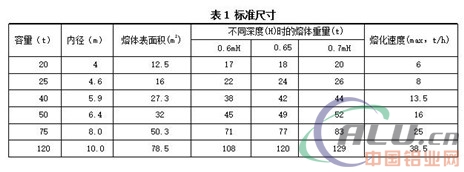
2) The furnace type is not matched with the furnace. As a result, the auxiliary time for loading and unloading the furnace is too long and the production efficiency is reduced. Generally speaking, enterprises that use solid materials as charge materials should use round furnaces with top-loading materials, and companies that use electrolytic aluminum water as their main charge materials can use rectangular furnaces; and dumping furnaces or dual-flow ports can greatly shorten the time for furnace discharge. We can see that some well-manufactured domestic enterprises, such as the 110-ton circular furnace of Xiamen Aluminum Strip Factory, are loaded with 25-ton slag-type drums. The total loading time is about 40 minutes, and φ90mm dual-stream outlets are used. Only 20 minutes are required for the tapping time. In some enterprises, although the furnace capacity is only 75 tons, and the furnace type is a rectangular furnace, the feeding method is an ordinary forklift instead of a sealed, special-purpose charging car with a width equal to the furnace door. As a result, only feeding is required. More than two hours, not only reduces the production efficiency, but also increases the heat consumption.
3) The determination of the furnace capacity must match the capacity of the casting machine. This problem is more prominent in the aluminum alloy casting and rolling plant. In China, the standard of casting and rolling workshops is usually 1+1+1, ie, one smelting furnace, one standing furnace, and one casting machine. According to the current state of the art, the output of a single casting mill is generally 1 to 1.5 t/h, and the output in one day is between 24 to 36 tons. In this case, the capacity of the aluminum melting furnace is made too large. Big is not conducive to energy saving. The general capacity should be 1 - 2 roll weight is appropriate.
The choice and matching of the furnace is reasonable, which determines the production efficiency, energy consumption and material consumption of the furnace, and also determines the production capacity and production cost of the ingot products.
With the enlargement of the furnace, the hydraulic semi-continuous casting machine with the guide has been designed to achieve one furnace and one large furnace. With the specification range given by YS/T590-2012, the current domestic flat casting ingot is larger. Thickness up to 700mm, width 2930mm, length 10 meters, the actual spindle weight has also reached 34 tons. In the recent 20 years, nearly 100 sets of hydraulic casting machines with more than 60 tons of domestic production and introduction were basically equipped with automatic casting systems, which greatly improved the level of casting automation. China's introduction of LHC low-level surface casting technology, mainly from Wagstaff, Almex and Novelis, the application of this technology has greatly improved the surface quality of China's flat ingot and the quality of the internal crystalline structure, but compared with traditional DC casting, some The company has experienced a significant decline in the rate of production. The decline in yield is mainly reflected in three
On the one hand, eucalyptus has many waste products (especially for the production of flat slabs for CTP slabs); the second one is for the head (with gate shrinkage 120mm) and the tail (bottom thickness difference 650mm) for removal; More waste. Therefore, while introducing new technologies, we should carry out second innovation on the basis of digestion and absorption. This seems to be our responsibility.
Here, it should be particularly pointed out that the low-frequency (5-30HZ) electromagnetic casting technology invented by Cui Jianzhong et al. of Northeastern University improved the crack resistance of the alloy (increased the melt flow rate in the mold, enhanced the heat dissipation during solidification, and significantly refined the structure. Significantly improve the segregation) and reduce the stress and strain in the ingot due to thermal contraction (change the temperature field in the crystallizer, reduce the depth of the liquid cavity) in two aspects to effectively inhibit the cracks of the high-content alloy ingot is a worthy Everyone is concerned about the good way.
Alloy composition optimization
The optimization of alloy composition is actually a matter of designing internal control standards for chemical components. It should be the responsibility of the company's technical department or technical manager. However, many companies nowadays are in the casting shop. The reason why this problem is important is whether it concerns the stability of product performance, whether the production process is stable, and whether the yield and cost are stable. Once the cast is made into an ingot, the subsequent steps cannot be solved. In general, the three basic parameters that determine the properties of aluminum products are composition, process (melt casting, calendaring, surface treatment) and heat treatment, and the composition is the decisive factor for the aluminum processing performance and end-use performance. Certain ingredients require a certain processing technology and heat treatment conditions, and correspond to a certain final performance. The better composition of the alloy can not only stably satisfy the performance requirements, but also control the composition in a relatively narrow range from a wide range of external standards to stabilize the production process and production cost.
In composition optimization, we must consider not only satisfying the requirements for casting properties (cracks tendency, propensity to generate intermetallic compounds, fine structure, etc.), but also the requirements for subsequent processing performance (mainly process plasticity), which of course is more important. Is to meet the requirements of technical conditions (ie contracted mechanical properties), but also to ensure that the user's requirements (for the sheet, the main formability, bending, corrosion resistance, electrical conductivity, thermal conductivity, processing stripes Such surface quality, these requirements are often not reflected in the technical standards, but it is the user is very concerned about, aluminum manufacturers should be satisfied), but also to meet the requirements of component analysis errors, and to ensure compliance with national security regulations. In addition, the optimization of the alloy composition is one of the important means for improving the overall performance of aluminum materials in recent years, and often achieves unexpected results.
The primary purpose of composition optimization is to enable the manufactured product to meet the mechanical performance requirements of its technical conditions, which can be solved by looking up the composition-mechanical performance charts of the relevant series of aluminum alloys.
The direct purpose of composition optimization is to solve the problem of the tendency of ingot cracks. The author published the article “Effects of High-Strength Aluminum Alloy Compositions on Crack Propensity of Ingots†at the Technical Conference of the Light Metal Division held in Guangzhou in September 2006. The systematic discussion of crack propensity and composition control methods for 2×××, 5×××, 6×××, 7××× alloys is available for everyone's reference. I will not repeat them here.
In addition, with the increase in the production of high-content alloys, the problem of intermetallic compounds in the ingots during semi-continuous casting often occurs. Generally speaking, intermetallic compounds are generated in the ingot and must have three conditions: First, the composition conditions, that is, the composition of the alloy must be located near the eutectic point or peritectic point; the second is the temperature condition, that is, the molten The body temperature must be lower than the liquidus temperature of the alloy. Third, the nucleation conditions, that is, the conditions related to the metal flow and the nucleation time. Under the unbalanced crystallization conditions of continuous casting of aluminum alloys, the concentration limit of the occurrence of primary crystals of intermetallic compounds is much lower than in the equilibrium diagram. Therefore, when using a continuous casting method to produce refractory iron,
When the nickel, vanadium, titanium, manganese, chromium, niobium, chromium, boron, silicon deformed aluminum alloy ingots, intermetallic compounds often appear, and have an important influence on the mechanical properties and surface properties of the products.
Regarding the composition conditions of primary crystal formation of intermetallic compounds, many literatures at home and abroad have been studied. The following formulas can provide you with reference:
Critical conditions that do not form (Fe,Mn)Al6 compounds:
For 3003 (3A21): Fe + Mn <1.8%;
For the 3004 alloy: wt% Fe + 1.07 wt% Mn < (T–587.9)/36,4;
The critical condition for forming (Zr, Ti) Al3 compounds is: wt% Zr + 0.909 wt% Ti <0.127 (eg 7No1 alloy);
Critical conditions for the formation of (Cr,X)Al7 (X=Mn,Fe,Ti) compounds:
For the 5083 alloy: wt% Mn + 3.18 wt% Cr < (T–565.8)/85.9;
For the 7075 alloy: wt% Mn + 3.25 wt% Cr < (T-600.9)/53.7.
Third, pure melt purification
There are many inclusions in the aluminum alloy, including oxides, carbides, nitrides, borides, various chlorides, fluorides, etc., as well as hydrogen, CO2 and other gases. These existing inclusions not only increase the melt viscosity, reduce the melt flow, promote the formation of looseness, but also hinder the removal of hydrogen, destroy the continuity and compactness of the metal, generate concentrated stress sources, and provide the core for the initiation of fatigue cracks. Inclusions also form hard spots in the aluminum alloy, reduce corrosion resistance when the potential of the base metal electrode is different, and also cause defects such as streaks in the subsequent processing, which greatly reduces the yield. In short, the impact is negative. Therefore, many scientific research institutes have conducted research on this.
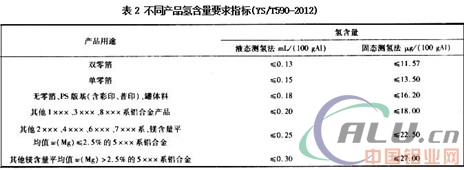
At present, in the production process of slabs, the following problems still exist in the pure purification of the melt:
1) The standard problem of pure purification. YS/T590-2012 stipulates the hydrogen content standards of various aluminum alloy melts (see Table 2), while there is no clear regulation on the slag content, and only says that “the purity of flat ingots is usually determined by the amount of slag content and How much to determine, slag content is usually measured using on-line LIMCA slag measurement, according to the different uses of the product to determine the slag content indicators, but also can be used to negotiate between the parties to ensure the use of technology. It can be seen that the domestic research on inclusions in aluminum melt is still at a low level. To this end, the National Key Basic Research and Development Program (973) has made reducing the content of inclusions in aluminum and aluminum alloys an important research content. The technical index proposed is that the total inclusion content is less than 0.02% and the size is less than 10 μm. Obviously this is a low indicator. What concept? It has been calculated that even with an inclusion concentration of 1 ppm, in the case of an average inclusion size of 40 μm, it means that there are about 11,000 particles per 1 kg of aluminum melt. Although the inclusion content is not high, the amount is surprising. In steel, there are data that inclusions <5μm, can be considered no effect on fracture toughness, while inclusions <1μm, can be considered no effect on fatigue strength. S. Ruddnik pointed out that only when the size of non-metallic inclusions is less than 1 μm, and the number of non-metallic inclusions is small and the distance between inclusions is greater than 10 μm, the macroscopic properties of the material will not be affected. It can be seen that with the development trend of thinning and lightweight aluminum materials, the market demand is getting higher and higher. We should pay great attention to inclusions.
2) The configuration problems of the degassing equipment and the deslagging equipment that achieve the pure purification target. YS/T590-2012 puts forward requirements for the production process of flat ingots that the on-line purifiers should be used when the products are used in aerospace materials, A-grade or above level inspection products, PS plate bases, beverage cans, etc. Melt treatment, grain refinement at the same time, degassing should be treated with dual rotor or more rotors, filtration should adopt two-stage filtration or multi-stage filtration using ceramic foam filter and deep bed or tube filter . Grain refinement should be conducted with on-line seeding using high-quality grain refiners; on-line degassing and purifying devices should be used when producing other products. This is a minimum requirement. The reason for this requirement is that the flow rate of metal per unit time during the casting of flat ingots is large. In order to ensure the effect of degassing and slag removal, double-rotor or multi-rotor degassing and double-stage filtration must be adopted for products with strict requirements. The problem with actual production is that only the installation of the facility is considered, but the actual time that the outgassing can be achieved and the filtration speed at the time of filtration are not studied. In general, the flow velocity of the metal during slab casting is slow, and the degassing and deslagging effects are good. However, when the flat ingot is cast, due to the large metal flow rate, the degassing time is insufficient and the filtration speed is faster, so the effect is poor. This depends mainly on the volume of the degassing tank and the total area of ​​the filter. Some of the charts (data) provided below are available for everyone's reference in production.
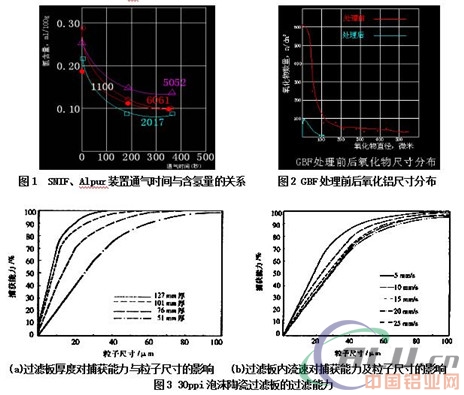
â–²PoD-FA measurements and metallographic examinations show that more than 90% of the inclusions in the ceramic foam filter plate are removed.
▲There is data indicating that a filter with a 40ppi ceramic foam filter can remove 5μm of inclusions by up to 50%.
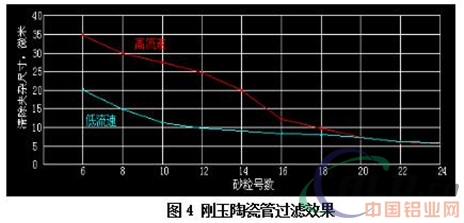
â–² Caesar Aluminum Corporation in the United States dissolved the sample in hydrochloric acid solution, and then collected the residue with microporous filter paper. Before filtration, the metal 320 ppm 5 micron size inclusions were generally reduced to 250 ppm after refining and removed after filtration, that is, 5 micron. For the above particles, the filtration efficiency reaches 100%.
Fourth, the organizational structure is refined
YS/T590-2012 requires that cracks, pores, feather crystals, non-metallic inclusions, coarse metal compounds, and white spot defects are not allowed in the low-power microstructure of flat ingots; grain size is not greater than Grade 3 (see GB/T3246.2). , Loosing is not more than two; other defects are negotiated between the supplier and the buyer. The microstructure only dictates that the homogenization state does not allow overheating. In fact, the organization is a guarantee of various properties, and current research shows that fine grains, small secondary branching, and small secondary phases of metal compounds always have beneficial effects on subsequent performance. At present, the knowledge we have acquired can help us to obtain a refined microstructure: using various grain refiners (such as Al-Ti-B, Al-Ti-C, Al-Ti-B-Re, Al- Ti-C-Re, Al-Ti-CPY, Al-Cu-P, mixed rare earths, P-Sr-Ce composite modification, etc.) and improvement of the use conditions, and various new processes (such as LHC and electromagnetics) that enhance the cooling rate Casting, semi-solid casting, spray casting, etc.), homogenizing the ingot, controlling the appearance of primary crystals of intermetallic compounds, and using homogenization treatment of transition elements such as Fe, Mn, Cr, Zr, and V, and heating before extrusion The precipitation characteristics cause fine dispersed particles and precipitated particles, the use of positive segregation elements and negative segregation elements in combination, and the use of low-concentration ingots to replace large-size ingots when the concentration is too cold to increase the degree of supercooling at the crystallization front. and many more. For more than a decade, the research of a new generation of electromagnetic casting and high-power ultrasonic casting aiming at strengthening the movement of molten metal, influencing the solidification process, promoting heat transfer, mass transfer, achieving grain refinement, and improving the quality of cast slabs by external forces It is also very active. Many manufacturers have flexibly used the above knowledge to achieve gratifying results in the microstructure of micro-alloys. The main problem that currently exists in this area is the insufficient practical application of known refinements.
Fig. 5 - Fig. 8 are metallographic structures of aluminum alloy slabs produced by injection casting (rolling) and various conventional methods, and Fig. 9 is a schematic diagram of semi-solid rheological rolling, from which it can be seen that spray rolling and semi-solid Rheological rolling is a new method worth looking forward to. Compared with the traditional twin-roller strip casting technology, these new technologies have higher cooling speeds and productivity, and at the same time, more varieties of alloys are available.
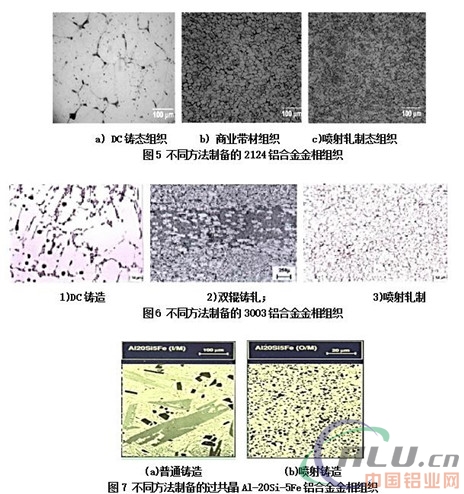
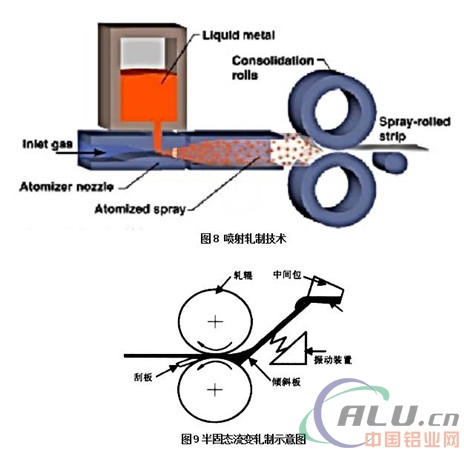
Different from the early electromagnetic casting process, a new generation of electromagnetic casting process arranges electromagnetic induction coils outside the crystallizer and reduces the height of the contact line between the metal melt and the crystallizer through the restriction of the electromagnetic force and changes the heat flux during cooling of the ingot. The temperature field and flow field inside the melt are released and melted, which effectively plays a role in refining grains and improving the surface quality of the ingot. Can also play a role in changing the distribution of solute elements, eliminating macrosegregation and micro segregation, and inhibiting the effect of coarse dendrite structure. In addition, the heat dissipation at the time of solidification is enhanced, the depth of liquid cavities is reduced, and the stress and strain generated in the ingot due to thermal shrinkage are significantly reduced, and cracks are effectively suppressed. FIGS. 10 to 12 show the state of the microstructure of the 7-series alloy when the crack is inclined in the vertical electromagnetic casting of a flat ingot and in the horizontal electromagnetic casting.

(Description: DCC - ordinary casting, LFEC - low frequency electromagnetic casting; CI = εe / εf, ie crack fracture index = larger equivalent plastic strain (εe) / allowable fracture strain at the temperature of the alloy at that location; applied electromagnetic field The conditions are: electromagnetic field frequency 5Hz - 30Hz, electromagnetic field strength 12,000 - 20 000 ampere)
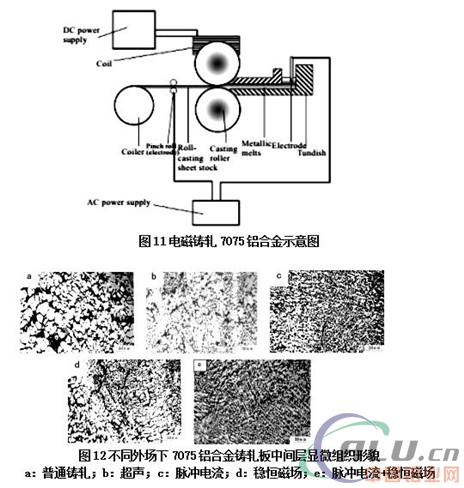
Ultrasound is a kind of high-frequency mechanical wave, generally more than 20kHz; due to its high frequency characteristics, cavitation, sound flow, and amplitude pressure and other special effects are generated when it propagates in liquids, and these effects require the ultrasonic sound pressure to exceed a certain level. At the threshold, high-energy ultrasound is those ultrasounds whose intensity reaches enough to produce these effects. High-energy ultrasound propagates in the melt in the form of longitudinal waves, forming sparse and dense phases in the melt; sparse phases are pulled apart by sound pressure to form cavitations, a phenomenon known as cavitation; cracking of cavities leads to The phenomenon of jet flow (ultrasonic wave velocity in the melt can reach 10-103 times the thermal convection velocity of the fluid), and generates high temperature and high pressure (Theoretical calculations and experimental measurements show that this instantaneous local high temperature and high pressure values ​​are Up to 104K and 103MPa). Another important type of effect of high-energy ultrasound in metal melts is called the amplitude pressure effect. The effect of the amplitude pressure is due to the fact that near the solid and gas barriers in the metal melt, the sound pressure is not uniform, so there is a net pressure on these obstacles, called the amplitude pressure.
High-energy ultrasound has the effect of degassing and slag removal, homogenization of components, and refinement of tissue during melt processing. When a hole is formed, it corresponds to a low-pressure zone (even vacuum). The gas dissolved in the liquid phase will overflow and accumulate in the cavity, forming a bubble, and the bubble will grow up and go up, so that the purpose of degassing is achieved. The process of bubble floating facilitates the introduction of foreign particles onto the surface of the melt to achieve a certain slag removal effect. The homogenization of the melt by high-energy ultrasound is based on the stirring effect of the acoustic flow effect. The high-energy ultrasound depends on the macroscopic acoustic flow, and the stirring effect is unmatched by the traditional mixing method. It not only makes the distribution of solid materials in the liquid more uniform, but also the liquid surface is more stable. In addition to the macroscopic sound currents in the melt, there are also microscopic sound currents that are similar to or even smaller than the ultrasonic wavelength, which promotes mass transfer and heat transfer. The mechanism of high-energy ultrasound acting on the solidification process to refine the microstructure is still controversial. Eskin believes that the refinement is due to the fact that impurities are “activated†into crystal nuclei under the action of ultrasonic waves to increase the nucleation rate and achieve grain refinement. Chen Feng believes that when the cavitation bubble breaks, it generates high temperature and high pressure (according to the Crablon formula), the equivalent supercooling degree of the melt is increased, and the nucleation rate increases. A currently accepted and relatively broad interpretation is that a possible comprehensive mechanism leads to the refinement effect of high-energy ultrasound on metal solidification, which can be summarized as follows:
1 The effect of the amplitude pressure generated when a cavitation bubble bursts may break the already grown dendrites, thereby inhibiting the growth of columnar crystals;
2 The micro-scale acoustic flow effect acts on the solid-liquid interface, so that the original solidification temperature gradient becomes gentle, even reversed; on the one hand, the solidified dendritic regions may be reheated, and the dendrites may re-melt, on the other hand, The temperature of the melt away from the solid-liquid interface may drop significantly, thereby facilitating the renucleation, which also has the effect of inhibiting the growth of columnar crystals;
3 Macro-scale acoustic flow The dendrite broken by the above two processes is stirred into the liquid stream and distributed throughout the melt, becoming the core of further nucleation and contributing to the formation of fine equiaxed crystals.
Fig. 13 shows an ultrasonic device mounted on a casting mill; Figs. 14-16 show the effect of ultrasonic treatment of various alloys.
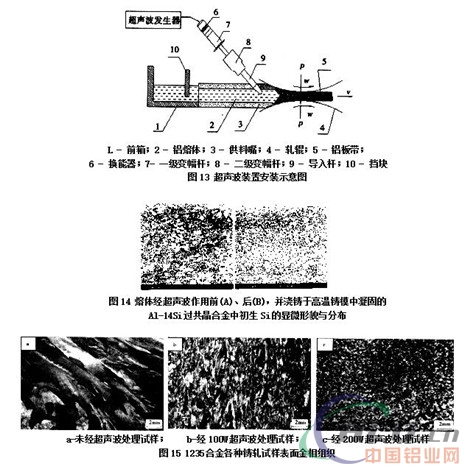
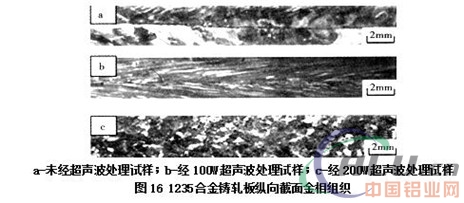
Five Ingot homogenization
The widely used magnetic stirring technology not only accelerates the melting process and reduces the labor intensity, but also uniforms the melt composition and temperature, improves the alloying quality level of the melt, and plays a very good role in the large-scale melting furnace. Here we mainly talk about the issue of homogenization.
The purpose of ingot homogenization is to eliminate or reduce intragranular segregation and to analyze the supersaturation in the solid solution, eliminate the internal stress generated during the solidification of the ingot, and make the cast alloy have greater chemical homogeneity and uniform organization. Improve the thermal deformation and cold deformation capability of materials (processability), improve the mechanical properties of semi-finished products, especially thick and thick semi-finished products, and improve the deep drawability of finished products.
During the homogenization process, the ingot will undergo: 1) dissolution of soluble elements (copper, magnesium, zinc, silicon, etc.) into the solid solution (ie dissolution of unbalanced eutectic and soluble intermetallic compounds), 2) The process of precipitation of the insoluble elements (iron, manganese, chromium, titanium, zirconium, vanadium, etc.) from the supersaturated solid solution, 3) the excess phase not transferred into the solid solution (such as the twig shape in the high-magnesium aluminum alloy ingot) The process of agglomeration and spheroidization of magnesium and silicon compounds, 4) the process of transition from metastable phase to equilibrium phase formed during solidification (such as the formation of metastable phase A16 (FeMn) to α-All2 (FeMn) ) 3Si phase transition). As a result, the chemical composition in the grains became uniform and the structure became uniform. The plasticity of the 7A04 alloy ingot was increased by 0.5 to 1 times, the relative elongation of the 2A14 alloy ingot was increased by almost 2 times, and the relative elongation of the 5A06 alloy ingot was increased. With a 0.5-fold increase, the ear rate of the 3004 alloy is greatly reduced, the deep drawability of the industrial pure aluminum and the 3003 alloy is also improved, and the tendency to form coarse crystals in the semi-finished 3A21 alloy is eliminated.
However, the current issues that should be noted are:
1) The effect of the homogenization treatment depends on the original structure of the ingot, which in turn depends on the casting conditions. Therefore, the work to increase the plasticity of the ingot should not only be started from the selection of homogenization system, but should be carefully analyzed from the casting conditions and options. It can be assured that a system with a finer and uniform second phase distribution along the ingot cross section begins.
2) The effect of homogenization on the performance of the semi-finished product mainly depends on the extent to which the solid solution of manganese, chromium, zirconium, iron, or some other insoluble element added to the alloy is added to improve the strength properties. Tests indicate that the preferred precipitation temperatures of the above-mentioned elements have different experimental results and are generally considered to be: Mn-400°C, Ti, V-450°C-500°C, Fe, Zr-500°C, Cr-600°C- -630°C. This is different from the homogenization temperature that is generally determined from the solid solution angle. Therefore, from the standpoint of achieving a homogenization effect, a multi-stage homogenization method should be used to achieve different effects in different temperature ranges.
3) From an economic point of view, it is preferable to increase the heating temperature to shorten the holding time. Generally, rapid heating is performed within the allowable heating speed range of the mass, and the temperature error range of the uniform heat treatment is controlled within ±10°C. If the temperature is too low, the processing performance of the final material may decrease and the crystal grains may become coarse. Therefore, care must be taken. If the temperature is too high or the heating speed is too high, eutectic melting may occur. However, from the current domestic heating capacity of the heating equipment, it is generally small, the heating rate is controlled within the range of 300 °C / h, the general aluminum alloy does not occur eutectic dissolution phenomenon, for 1 series (including 8 series Some), 3 series, 6 series alloy can be controlled in the 600 °C / h range.
4) The selection of a flat ingot homogenization system shall take into account two basic conditions: that is, to ensure that the ingot will be rolled with less scrap and obtain the desired properties of the strip. The greater plasticity of these alloys, such as Types 2A12 and 5A06, can be obtained using high temperature homogenization. However, the average strength properties of sheet metal products have only marginal margins relative to technical standards, which limits the application of high temperature homogenization because it can result in some reduction in the properties of cold rolled sheet. For this reason, high-temperature homogenization treatment is not recommended for 2A12-type alloys, and 5A06-type alloys are recommended to be homogenized at a temperature range of 500°C-510°C, and the soaking time is limited to 3h-6h.
pressure transmitter is a device that converts pressure into a pneumatic signal or an electric signal for control and remote transmission. Pressure Sensor can convert the physical pressure parameters such as gas and liquid felt by the load cell sensor into a standard electrical signal (such as 4~20mADC, etc.), to supply secondary instruments such as indicating alarms, recorders, regulators, etc. for measurement and indication and process regulation.

Pressure transmitters are used in various industrial automatic control environments, involving water conservancy and hydropower, railway transportation, intelligent buildings, production automatic control, aerospace, military industry, petrochemical, oil wells, electric power, ships, machine tools, pipelines and many other industries.
There are two types of pressure transmitters: electric and pneumatic. The uniform output signal of the electric type is a direct current signal such as 0-10mA, 4-20mA or 1-5V. The unified output signal of the pneumatic type is the gas pressure of 20-100Pa.
Pressure transmitters can be divided into force (torque) balance type, capacitive type, inductive type, strain type and frequency type according to different conversion principles.
Our advantageous products are mainly compact pressure transmitters, pressure transmitters with display, differential pressure transmitters, wind pressure transmitters, etc.
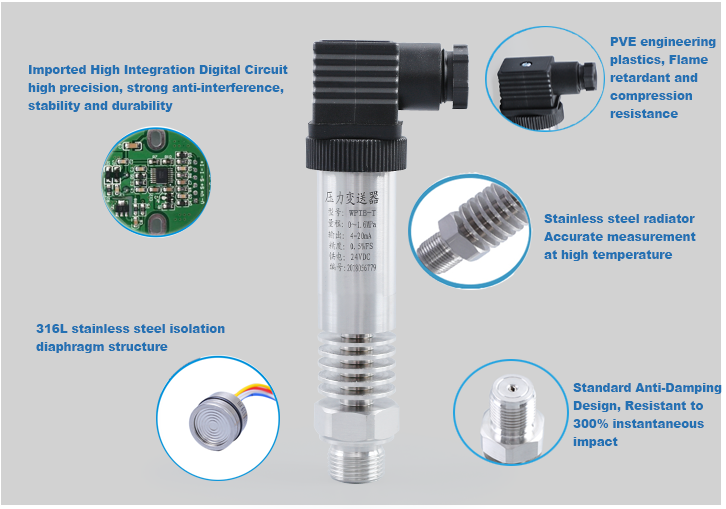
The main advantage
1. The pressure transmitter has the characteristics of reliable operation and stable performance
2. Dedicated V/I integrated circuit, less peripheral components, high reliability, simple and easy maintenance, small size, light weight, and extremely convenient installation and debugging;
3. Aluminum alloy die-casting shell, three-terminal isolation, electrostatic spray protection layer, durable;
4. 4-20mA DC two-wire signal transmission, strong anti-interference ability and long transmission distance;
5. LED, LCD, and pointer three kinds of indicator heads, the on-site reading is very convenient. Can be used to measure viscous, crystalline and corrosive media;
6. High accuracy and high stability. In addition to the imported original sensor that has been corrected by laser, the comprehensive temperature drift and nonlinearity of the whole machine within the operating temperature range are finely compensated.
Pressure Transmitter,Pressure Transducer Sensor,Digital Pressure Sensor,Pressure Transmitter 4-20Ma
Wuxi Winsun Automation Instrument Co., Ltd , https://www.jswxwinsun.com